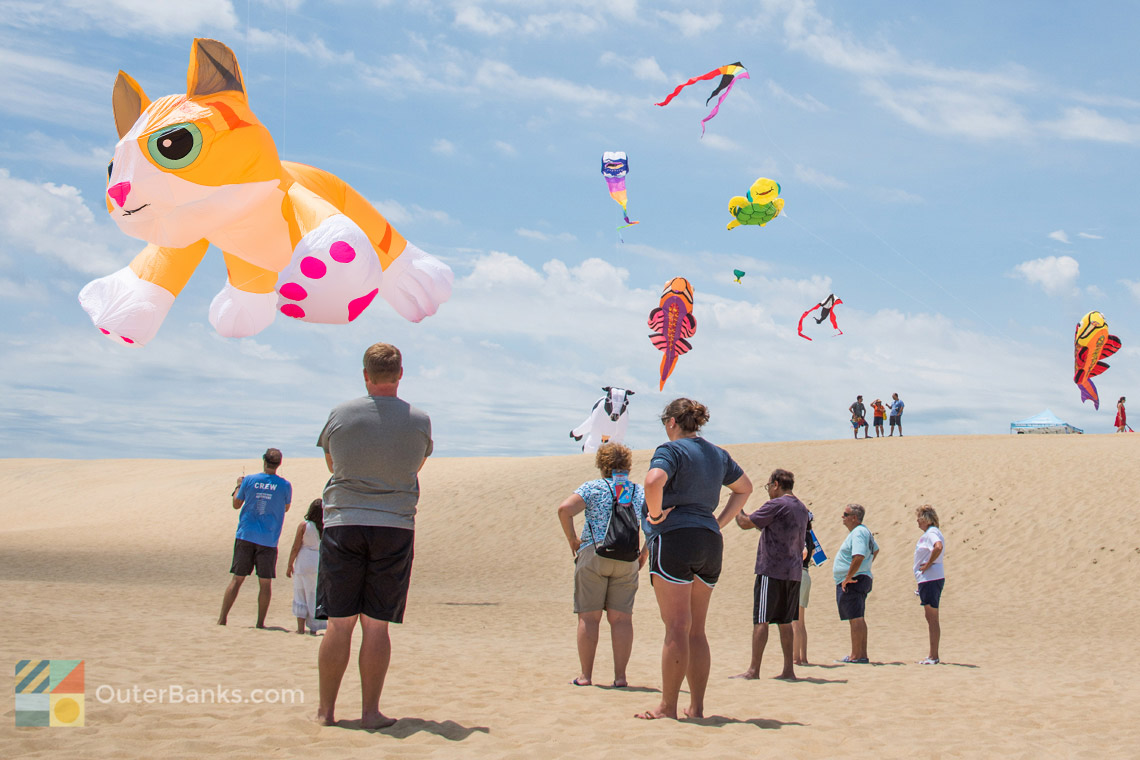You don't need a board, a boat, or any other special equipment to enjoy the waters off the Outer Banks. On a hot summer day, sometimes all you have to do is dive in.
Swimming is a popular local pastime on the Outer Banks, and with miles of ocean and sound waters to explore, there are plenty of places to take a dip. Vacationers will have several swimming options, ranging from the fun and difficult ocean waves to the shallow splashing waters of the sound, as well as the public and community pools found around the islands.
Whether you're a doggie paddler or a world-class swimmer accustomed to long distances, the Outer Banks has plenty of open water to explore.
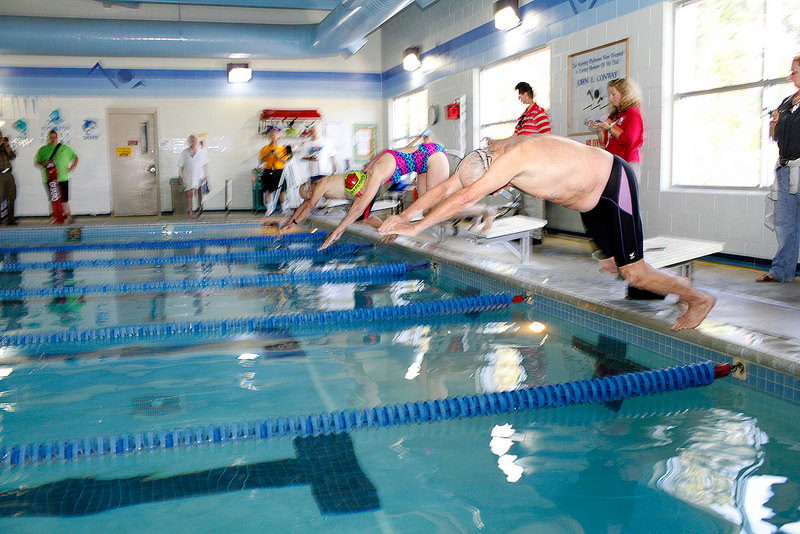
Private, Public and Community Pools
On the rare off-the-beach day, visitors also have the option to hit the pool. On the Outer Banks, every area has relatively easy access to a public or community pool, and many vacationers are delighted to find a large number of rental homes that feature private pools for anytime-swims right outside your door.
Over the past 10-15 years, private pools have become more of a commodity on the Outer Banks, and a growing number of vacation homes now offer it as an amenity to their rental guests. In fact, most of the homes available for weekly rentals that are 5 bedrooms or more offer a private pool, although it is also possible to book smaller 3-4 bedroom vacation homes with pools as well.
As a rule of thumb, the private pools offered by Outer Banks vacation rental homes are open from around Easter, (considered the first big tourism week), until October, and also have a "pool heat" option for an additional fee. Pool heat may be required in the spring and fall months when air temperatures will make swimming in an unheated pool a chilly venture, but not necessary in the prime summer months of late June, July and August, when the pool will be simply refreshing in the warmer sunny temperatures.
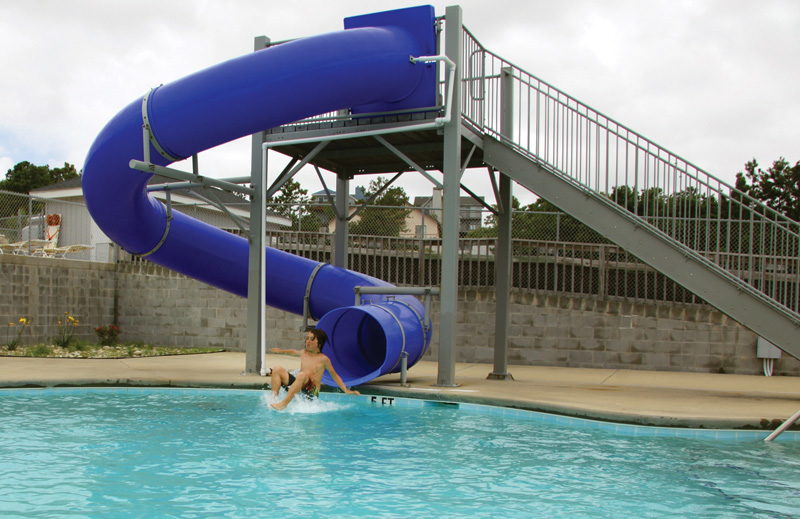
Be sure and check with your vacation rental company well in advance of your vacation about your pool heat and private pool options. Reservationists can usually guide Outer Banks newcomers through the selection of homes with pools, and help them choose the perfect one for their family.
Many communities and subdivisions also offer community pools as well. These pools are typically larger than the ones at private vacation homes, may or may not have lifeguards on duty seasonally, and are only open to vacationers staying in that particular neighborhood. Condominium communities, and local hotels and motels especially, typically have at least one outdoor community pool on-site, and several elite communities, (like the Currituck Club in Corolla), may even have indoor pool options as well for winter guests.
In the absence of a community or private pool, most major Outer Banks communities also have public pools available for visitors for a small daily fee. The Outer Banks YMCA in Nags Head features both an indoor pool and a kids' outdoor pool, seasonally open, and short-term memberships are available for visiting guests. Please check with the YMCA for current day and week pass options available for swimming and outdoor fitness as these options vary due to current COVID-19 restrictions. Note that some vacation rental homes in the Nags Head area offer a free membership to the YMCA as an amenity, so you many want to check with your vacation company to see if properties with this feature are available for your vacation.
Several vacation rental companies also offer public pools as an amenity for their guests. For example, both Hatteras Realty and Outer Beaches Realty on Hatteras Island have a public pool available for guests, or for visitors for a small daily or weekly fee. Again, your vacation rental company is your best resource for finding public pools in your specific area of the Outer Banks.
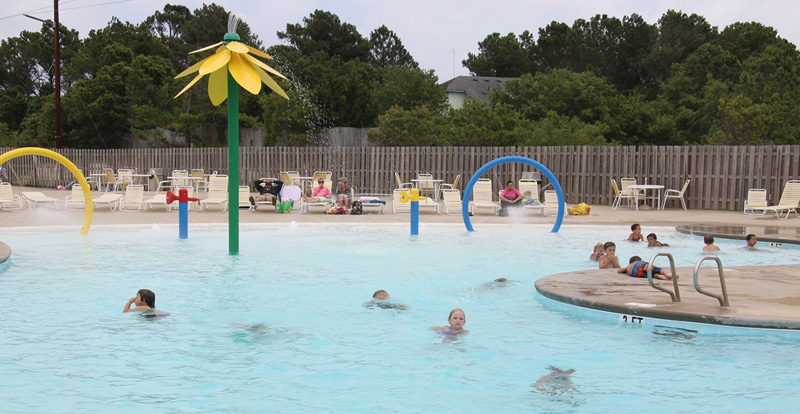
Regardless of where your family stays on the Outer Banks, a refreshing swim is literally just around the corner. Accomplished swimmers will love challenging themselves with mile-long swims along the ocean shoreline, and young ones can join in the fun in the calm waters of the Outer Banks' five saltwater sounds. Naturally, anyone can enjoy a day at the pool, either in their rental community, their neighborhood, or even in their own backyard.
The Outer Banks is ideal for water lovers, and with more water than land comprising this cluster of barrier islands, it's easy to get your toes wet in the local swimming scene. For a purely refreshing vacation, there's no better way to clear your head from everyday drama than throwing on the swim suit, finding your nearest body of water, and taking the plunge.
Ocean Swimming
Taking a dip in the ocean can happen anytime, along any stretch of Outer Banks shoreline. Whether you're staying in the 4WD beaches of Carova, or the charming village of Ocracoke, if you're on the Outer Banks, there's certainly a beach nearby waiting for you to get your toes wet.
The number one tip for enjoying a good ocean swim is to master the waves. The Atlantic waves along the Outer Banks coast vary by location, ranging from small foot-high ankle skimmers to towering 4-6 ft. waves that crash close to shore. Obviously, smaller waves are easier to navigate, but large waves may quickly transform a relaxing swim into a painful, sandy wipe-out.
Swimmers have two alternatives for negotiating huge waves. They can swim out into the water and "jump" over the waves before they break, or better yet, dive beneath the waves just before they break. To accomplish this, dive as deep as possible beneath the wave and then return to the surface once the wave has passed. This may require some practice, but once mastered, it is similar to riding a bike - an ability that ocean swimmers will never forget.
Of course, the simplest approach to avoid waves is to swim out past the breaking surf. It's generally evident where the "line" of waves ends, and if a swimmer gets past the breakers, they'll be safely out of the way of the crashing surf.
As for water temperatures, seasonal visitors can expect to enjoy warm ocean water from June well into the fall. While it takes a while for the ocean waters to catch up to the air temperatures, but once warm, the ocean generally stays warm until early October, allowing even fall visitors to enjoy a good Atlantic swim. Ocean temperatures also vary greatly by area. In general, the waters off the coast are much cooler along the northern Outer Banks communities of Carova, Corolla, and Duck than the southern villages of Ocracoke and Hatteras.
In fact, geography plays a huge role in ocean temps, as evident by the beaches on Hatteras Island. Visitors often notice a perceptible difference in water temperatures north and south of Buxton. The reason is that this Buxton, specifically Cape Point, is where Hatteras Island "hooks" to the west, resulting in south facing beaches past Cape Point. As such, southern currents and temperatures affect this area more than northern Hatteras Island, so a beach in Frisco Village may be 5 degrees warmer than in Avon, located just 15 miles away.
Wind and currents also play a role in temperatures and wave conditions. A strong current or consistent breeze can easily stir up the ocean waves, and the direction of both the current and wind can affect water temperatures. In essence, any given beach day can be uniquely different from the day before, and ocean conditions can change from one town to the next. By exploring different beaches in different weather conditions, a swimmer can always enjoy a new challenge, in a varying Outer Banks environment.
Best Places to go Ocean Swimming
When it comes to swimming in the ocean, where rip tides, currents and rough surf can all affect swimming conditions, safety is key, and many beaches along the Outer Banks offer lifeguards, roving patrols, or gentler waters for ocean swimmers.
The Northern Outer Banks is ideal for vacationers who want to enjoy an ocean swim, as there are a number of lifeguarded or patrolled beaches all along this stretch of shoreline.
In Corolla, 7 roving ATV Ocean Rescue units patrol the beach, generally from late spring until Labor Day, staying on the lookout for swimmers in danger. In addition, Corolla also has between 12-15 lifeguard stands which are seasonally operational from Memorial Day to Labor Day, 9:30 a.m. until 5:30 p.m. These stands are spread across Corolla, from mile marker 3 to mile marker 13, so virtually every community is close to a lifeguarded location.
The village of Duck, located just south of Corolla, also has a number of lifeguard stands which are in operation from May 1 until October 31. These stands are manned from 10:00 a.m. until 6:00 p.m. and are stationed in five locations within Duck's limits. Vacationers will find lifeguarded beaches on Sprigtail Drive, Barrier Island Station, Schooner Ridge Drive, Four Seasons Drive, Scarborough Lane, and Plover Drive. Neighboring Southern Shores also has two lifeguarded beaches, located at Chicahauk Beach and Hillcrest Beach, rounding out the northern Outer Banks' reputation as home to some of the safest and best guarded beaches on the 'Banks.
The central Outer Banks is equally well-guarded, with lifeguard stands stationed in Kitty Hawk, Kill Devil Hills and Nags Head. These stands are located every quarter - half mile or so, and generally border public beach accesses, allowing vacationers an easy route to finding and playing at a lifeguarded beach.
In Kitty Hawk, three lifeguard stations can be found which are manned from 10:00 a.m. - 7:00 p.m. There are a whopping 18 lifeguard stands in Kill Devil Hills, all open from 10:00 a.m. until 5:30 p.m., and Nags head has an impressive number of lifeguard stands as well, with 11 total stands operating from 10:00 a.m. until 6:00 p.m.
All three towns are also protected by roving patrols, which are generally in service from May until mid-October. In addition, the beaches have instilled a red-flag system on windy days that are conducive to rip currents, so swimmers are warned well before their toes hit the water.
Despite the expanse of Hatteras Island, stretching across 50 miles of Outer Banks coastline, the area only has one lifeguarded beach, located next to the "Old Lighthouse Location" in Buxton. (To find the spot, simply turn towards the Cape Hatteras Lighthouse, and head for the expansive oceanfront parking area.) This lifeguarded beach is open seasonally, generally from Memorial Day until Labor Day, and is tended during daylight hours.
That said, there are several stretches of shoreline on Hatteras Island that are better for novice swimmers. The beaches between Frisco and Hatteras Village typically have gradual, sloping shorelines which result in both smaller waves, and waist-high waters extending many feet out into the ocean. This allows swimmers to enjoy gentle ocean conditions, while still being able to walk out well past the smaller breaking waves.
Ocracoke Island has a similar ocean landscape, particularly in the summer months when the weather is warm and free of seasonal storms or nor'easters. Here, swimmers can also wade gradually into the water, or stick to tidal pools that often make an intermittent appearance along the 13+ miles of shoreline from the ferry docks to the village. Ocracoke visitors will also find a lifeguarded beach just a couple miles outside of town, distinguishable by both National Park Service markers and a wide concrete parking area. This public beach also has bathrooms and even showers, making it a popular destination for Ocracoke beach lovers.
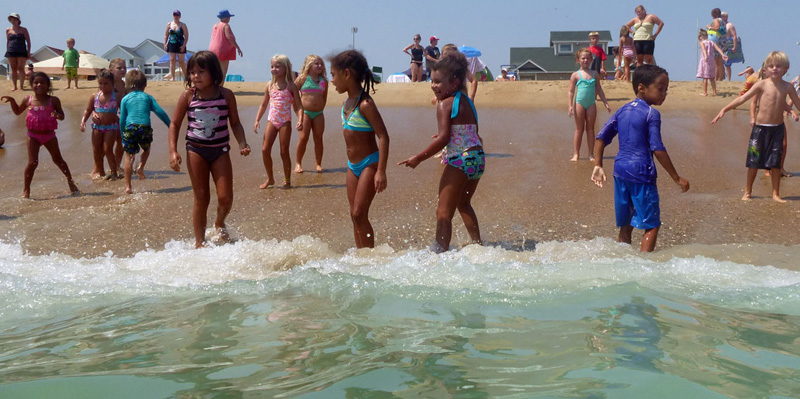
Rip Currents and Ocean Swimming Safety
Many first-time vacationers have a fear of sharks that stops them before they hit the water. Though not to be taken lightly, shark attacks are incredibly rare on the Outer Banks and occur once every 20 years or so. Considering how many thousands of visitors hit the beaches, the odds are definitely in a swimmer's favor. Still, to err on the side of caution, limit your evening swimming as this is when large fish are most likely to feed, and avoid swimming near piers, where lots of bait is consistently thrown into the water by pier fishermen.
Jellyfish can be a larger concern, as they make seasonal appearances in large numbers in all areas of the Outer Banks. Their random appearance and disappearance is a bit of a mystery, and is attributed to currents, wind and water conditions, as well as a number of other minor factors. Essentially, a swimmer can encounter dozens of jellyfish loitering the waves one day, and then enjoy a jellyfish-free ocean swim the next. Though typically not life-threatening, a jellyfish sting can certainly, well, sting. Clear jellyfish should not be minded, however jellyfish with dark red interiors, or with any sort of tentacles, should be avoided. If you spot a cluster of jellyfish with these traits while swimming, it might be time to take a break from the ocean.
The biggest safety risk with ocean swimming, however, is not sharks, jellyfish, or any other sea critter - it's rip currents. Most ocean swimmers know that rip currents can appear in exceptionally breezy or stormy weather, however they can also occasionally appear in the most ideal of weather conditions with a passing stray current.
To spot a rip current, look for unusual wave patterns that appear to be pushing out into the ocean, instead of breaking towards shore. Noticeable variations in the surf line can also be an indicator of rip currents, and swimmers should be on the lookout for large patches of white ocean wash that appear out of place, and remain consistent in a certain section of the ocean.
If you get caught in a rip current, the most important thing is not to panic. Typically, rip currents can only be deadly if you're unprepared. Stay calm and swim parallel to the shoreline in either direction. Because rip currents only affect a portion of the ocean, the key is to swim out of the rip current first before swimming back to the beach. Never try to simply swim towards shore, no matter how close you are, as a swimmer is no match for a rip current and this futile effort will merely tire a swimmer out.
To optimize your chances of not encountering a rip current, avoid windy days (with gusts of 20 mph or more) when the ocean is frothy and rough. Instead, hold out for those crystal clear beach days when the ocean is a Caribbean blue, and an Atlantic swim is smooth sailing. In the summer months, these beach days are abundant and most definitely worth the wait.
Sound Swimming
For swimmers who don't necessarily want the challenge or depth of an ocean swim, an alternative is literally right around the corner - the Outer Banks' wide array of saltwater sounds. Every beach town on the 'Banks borders a sound, a large salty body of water that is miles and miles wide and connects to the ocean via a series of inlets. The northern Outer Banks is adjacent to the Currituck Sound, the central Outer Banks town of Kitty Hawk, Kill Devil Hills, Nags Head and Manteo are located next to the Albemarle Sound, and Hatteras and Ocracoke Islands border the 30+ mile wide Pamlico Sound.
Though connected to the Ocean, the sound waters are considerably different from the ocean waves. Essentially, the sounds are large salty lakes, with shallow bottoms that extend at waist-deep levels for miles, small lapping waves, and clear or slightly brackish waters, depending on the currents and the location.
Because of this gentle nature, the local Outer Banks sounds are ideal playgrounds for small children. The youngest in your group can enjoy a full day of splashing, paddling and playing without running into deep waters or crashing waves.
Kids will love having a day of their own enjoying the waters, and although vacationers in search of an invigorating swim may find the shallowness of the sounds limiting, there are plenty of waves to get your feet wet. Many sound visitors bring a beach chair and a book along, set up a few inches into the water, and simply relax with the salt water gently lapping on their toes.
The Outer Banks sounds are also generally a few degrees warmer than the ocean throughout the year, due in no small part to their shallow depths, making a day at the sound a fantastic alternative when the ocean waters are just a little too chilly for swimming.
Best Places to go Sound Swimming
Vacationers will find a virtually unlimited supply of sound beaches all along the Outer Banks, as every beach town that borders the ocean also borders the sound. Visitors can opt to stay in a soundfront home or community for private sound access, or head to a number of public accesses located throughout the Outer Banks seashore.
In Corolla, visitors can hit the soundside beaches of the Historic Corolla Park for a wide, grassy soundfront beach and adjacent picnic area. Duck also has public sound accesses, including one centrally located access within the town park. This soundside area also features a lovely waterfront gazebo and several walking trails for exploring the Outer Banks both in and out of the water.
Kill Devil Hills and Kitty Hawk offer a number of sound access points, both in small public parking areas on the soundside, and bordering the Kitty Hawk Woods Preserve. The Kitty Hawk Woods Preserve also offers ample parking as well as boat docks for launching out to deeper sound waters, and enjoying more challenging swims off the side of the boat.
The Jockey's Ridge State Park in Nags Head also features a fantastic soundfront beach, which is arguably one of the Outer Banks' favorite soundfront locations. Home to a world of watersports, including kiteboarding, hang gliding, kayaking, and windsurfing, the soundfront beach at Jockey's Ridge also serves plain old swimmers and splashing kids, with miles of sandy and grassy areas to explore.
On Hatteras Island, visitors will find no shortage of sound access points, ranging from large paved parcels of land with seasonally opened restrooms and picnic areas, like the Salvo Day Use area just south of Salvo, to the small 4WD accessible only paths that access small, private beaches on the southern outskirts of Hatteras Village. Vacationers are encouraged to explore, (with 4WD vehicles as needed), and discover the series of private and secluded soundfront beaches that are scattered throughout the island.
For a soundfront splash with exceptional sightseeing, head to Canadian Hole, located almost exactly in between Avon and Buxton. This soundfront beach has become a hot spot for windsurfers, and with adjacent Kite Point, (a kiteboarding Mecca), just a quarter mile away, beachgoers here will encounter a picturesque view of dozens of colorful kites scooting across the background, and a fantastic view of the Cape Hatteras Lighthouse to boot.
Ocracoke Island also has a similar series of hidden and relatively secretive soundfront trails lining down NC Highway 12, but the village of Ocracoke has soundfront beach accesses as well. Follow the small nature trail at Springer's Point through clusters of maritime forest to discover a grassy and slightly rocky soundfront beach that overlooks the main ferry channel, and spend an afternoon in the water watching the big Swan Quarter and Cedar Island ferries making their rounds to and from the Ocracoke Harbor.
Clearly, no matter where on the Outer Banks a vacationer stays, there's always a soundfront beach just around a sandy bend, waiting to be discovered.
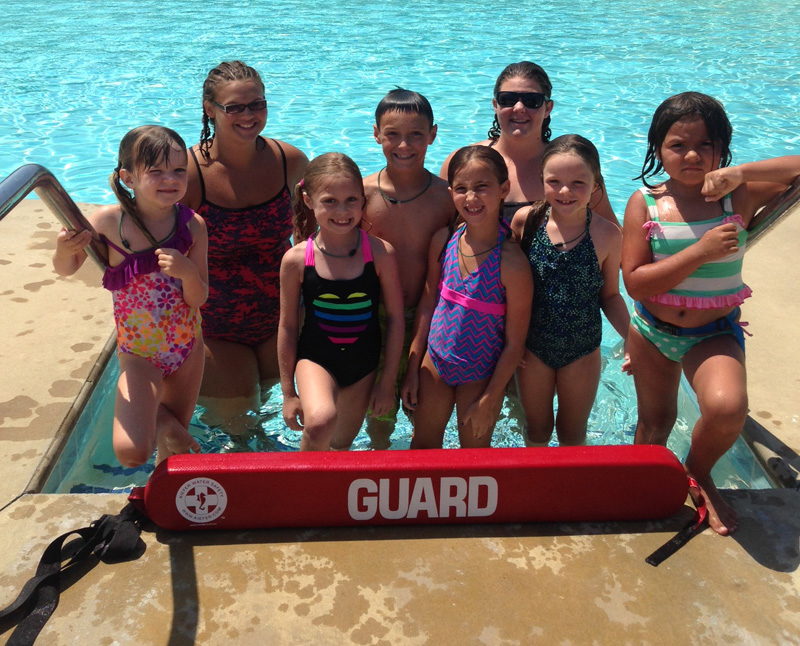
Sound Swimming Safety
While sound swimmers do not necessarily have to worry about rip currents, or the much lesser threat of sharks or larger fish, there are a few safety issues to keep in mind when splashing in the sound. Because the sound feeds off the Atlantic Ocean, the same marine life that calls the ocean home can also be found in sound waters, and this includes crabs and seasonal, sporadic jellyfish. Be on the lookout for colorful jellyfish, (not clear ones,) or any jellyfish with tentacles, as well as small blue crabs or hermit crabs that can deliver a pinch to unsuspecting swimmers.
In grassy, rocky and / or unpopulated areas, sound swimmers may also want to be on the lookout for water moccasins. Though rare, these water-loving snakes occasionally make appearances in grassy, rocky and brackish areas in the warmer summer months. Sandy beaches and sound bottoms, however, are typically safe sound retreats.
Sound swimmers should also steer clear of the inlets, specifically Oregon Inlet, Hatteras Inlet, and Ocracoke Inlet. The waters off the inlets, where the ocean channels into the sound and vice versa, can appear calm, but under the surface are raging currents pushing the saltwater to and fro. Swimming in inlet waters is akin to swimming in a rip current, except with much broader current borders making the inlets hard to escape. As a result, once pulled into an inlet current, swimmers will find it difficult, if not impossible, to swim out.
The biggest concern for sound swimmers, however, is the occasionally shelly bottom. Fragments of shells are common in the sound, and can cause cuts to the feet, particularly on windy days when the sound waters may not be as clear. Thankfully, "water shoes," or nylon / rubber booties that protect feet from the ocean or sound bottom, are available at most every gift and souvenir shore, and can be picked up and worn on the cheap.
For the little ones in your group, or for simply a relaxing and leisurely float, an afternoon at the sound is the perfect way to cool off, and still have a chance to submerge in the Outer Banks water sports scene.
-
Wings Over Water Encore
December 5th, 2025 - December 7th, 2025 -
Hatteras Island Christmas Parade
December 13th, 2025 2:00 PM -
The Holiday Hustle 5K & Elf Run
December 13th, 2025 11:34 AM
Outer Banks Mall is a large outdoor shopping center featuring everything you need for sun, fun and shopping. Located at MP 14 in Nags Head, the large shopping center features a wide variety of food & beverage providers; everything from breakfast...
While several of the Outer Banks' most popular sports seemingly flew onto the scene in the past decade or two, like kiteboarding or stand up paddle boarding (SUP), windsurfing has been drawing water sports lovers to the North Carolina coast for...
If you're searching for great pizza on the Outer Banks, look no further than Cosmo's Pizzeria at The Marketplace in Southern Shores! We offer authentic New York-style pizza made fresh and just the way you like, using only the highest quality...
Many newcomers to the Outer Banks who are browsing the local restaurants, shops and area attractions online or in the local guide books notice an interesting addition to the standard address. Besides the typical business name, street name, street...

